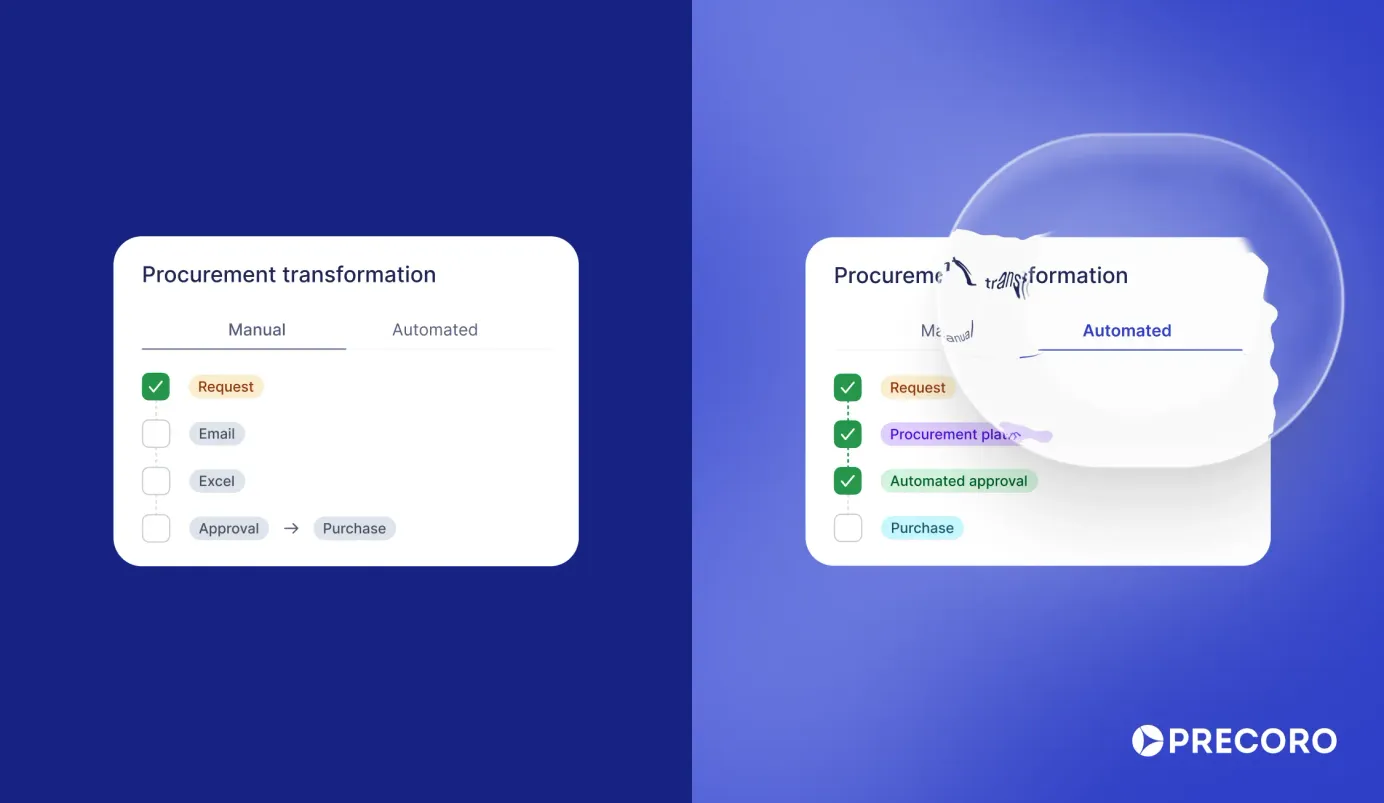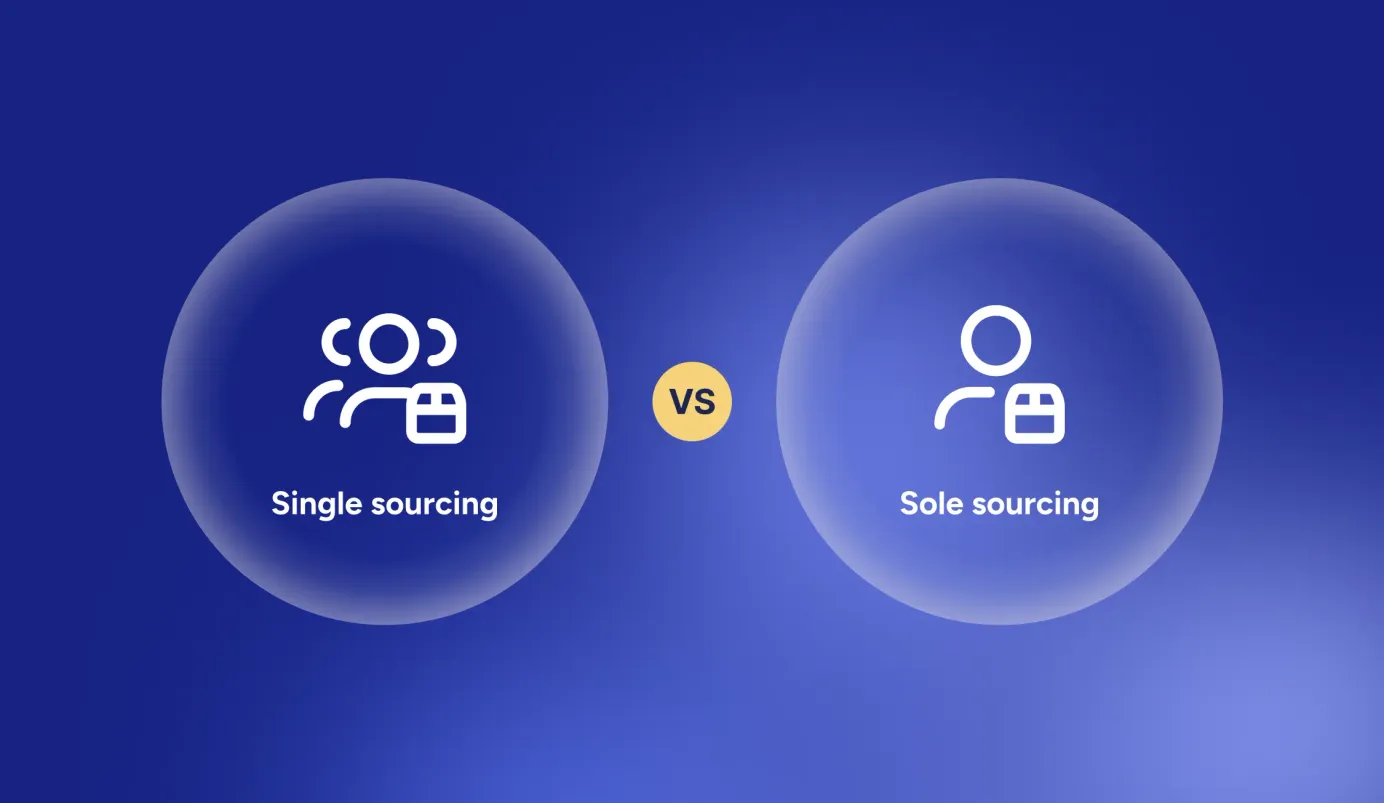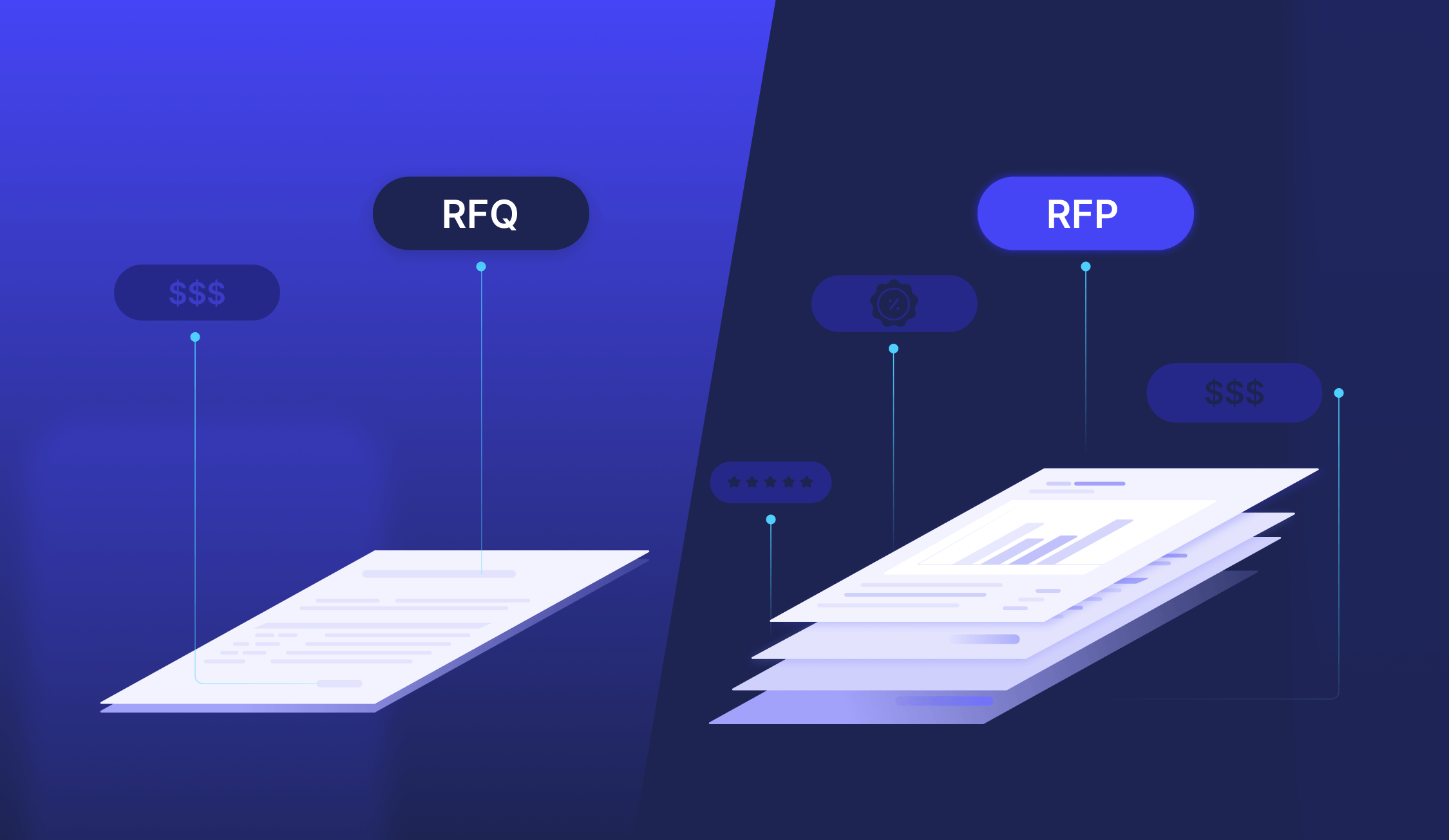
10 min read
RFQ vs. RFP: Which One Should You Use?
RFQ vs. RFP: Which one should your company use to choose the best deal among prospective vendors? Learn more about each document, their differences, and tips to simplify the RFQ and RFP processes.
Every procurement professional faces a time when they have to make a purchase in unfamiliar territory. Typically, it starts when an employee creates a purchase requisition to notify the department manager of the need for new goods or services. Alternatively, when an organization embarks on a new project, procurement managers are tasked with finding the ideal supplier that aligns with the project’s requirements.
If none of a company’s current vendors can fulfill the business needs, a procurement team has to find new potential vendors and gather their bids in a formal, structured, and comparable manner. That’s when RFQs and RFPs come into play. This article will explore the characteristics and key differences between them, as well as best practices to simplify document management.
Keep reading to find out:
- What is an RFQ?
- What is an RFP?
- RFQ vs. RFP: What are the main differences?
- What should you use: an RFQ or an RFP?
- Best practices in managing RFQs and RFPs
- Frequently Asked Questions
What is an RFQ?
An RFQ, or request for quotation, is a document used in procurement to solicit price quotations from potential suppliers or vendors for specific goods and services. Businesses use RFQs when they know what exactly they need, including product or service quality, quantity, and preferred payment terms.
For example, imagine a marketing team preparing for a major campaign that requires printed materials like brochures, banners, and promotional items. They already estimated the required items, quantities, and timelines; now, their focus is on exploring the prices and the ability of different printing and marketing agencies to meet their specific requirements.
Thus, businesses send RFQs to companies they’re interested in working with. A request for quotation usually includes the following details:
- Contact information of the buyer company (company name and address, contact name, phone number, and email address)
- Date issued
- Response submission deadline
- Instructions for quotation submissions
- Project length, description, and goals (if needed)
- List of desired items and their quantities
- Expected delivery timeline for the product/service
- Pricing expectations and the request for a full breakdown of the vendor’s costs (along with requisition number if available)
Maintaining consistency across RFQs is crucial. When the company asks each potential vendor for the same information, it’s easier to adequately compare responses and evaluate everyone based on the same criteria.
Once procurement managers receive supplier responses to requests for quotation, they review the options, compare costs, and select the supplier that meets the qualifying criteria and presents the best price. Then, the company sends a purchase order to the winning vendor, and, once accepted, it becomes a binding contract.
It’s a nice business practice to inform other vendors who submitted responses to the RFQ that they weren’t selected. By reaching out to them, companies demonstrate respect for the time and effort these businesses invested in preparing their quotations.
What is an RFP?
An RFP, or request for proposal, is a document used in procurement to invite multiple vendors to submit detailed proposals for the provision of goods or services. Businesses use RFPs after they map out the project’s scope, goals, and possible roadblocks, seeking comprehensive information about the vendor and its products or services.
For instance, a company plans to organize a large-scale corporate event, such as a product launch or an industry conference. It may issue an RFP to event management firms, requesting proposals that would include event planning, logistics, venue management, and budget estimates.
Therefore, organizations send out RFPs to assess bidder expertise and ability to undertake the project. A request for proposal usually includes the following details:
- Contact information of the buyer company (company name and address, contact name, phone number, and email address)
- Date issued
- Response submission deadline
- Instructions for proposal submissions
- Project length, description, and goals
- Skill and experience requirements
- Possible challenges in the project fulfillment
- Inquiries about the strategy and the action plan to fulfill the project
- Inquiries about references and reviews (if needed)
- Expected delivery timeline for the product/service
- Available budget or desired price range
When the company receives final submissions, it meticulously compares responses, eliminating vendors who don’t meet the criteria. As the list narrows down, procurement managers delve deeper into pros and cons, engaging in negotiations on pricing and technical aspects. At this point, the company may even ask the remaining bidders for a “best and final” offer before making a final decision.
After selecting the vendor, the company signs a contract with them or issues a PO to formalize the decision. It’s essential to finalize everything with the chosen vendor before notifying others they were not selected.
RFQ vs. RFP: What are the main differences?
Depending on the scenario, companies can use RFQs or RFPs to gather data from vendors and find the right fit for their business requirements. However, these documents share more differences than similarities.
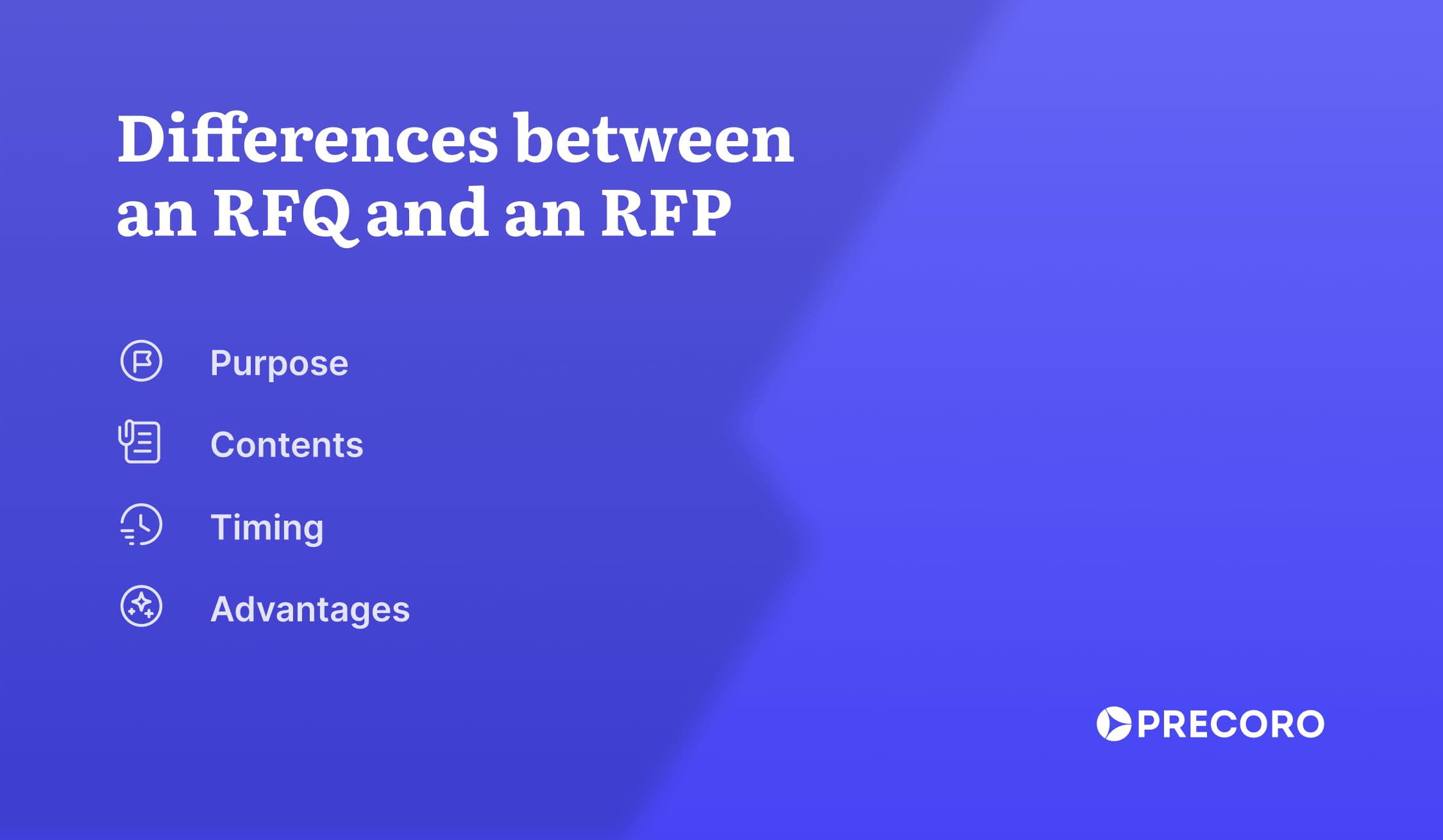
Purpose
When a company sends RFQs, it aims to find the best price. The organization is fully aware of what and how much they need. On the other hand, when an organization sends an RFP, it’s to compare vendor solutions, their expertise, and the ability to meet project objectives. Moreover, a request for proposal is used when there’s uncertainty about the specific products or services needed for a project.
Contents
The structure of an RFQ and an RFP is quite similar. Both typically include an introduction of the company with contact info, response deadline, project specifications, expected delivery timeline, and instructions for response submissions.
However, an RFQ is generally shorter than an RFP as the former provides only a brief overview of what’s needed (with exact specifications) and asks pricing questions. On the other hand, a request for proposal allows companies to delve deeper into explaining the project goals and asks vendors about their background, skills, strategy, and methodology to achieve the project objectives.
Timing
Companies send RFQs at the final stage in the decision-making process when they are ready to purchase. Conversely, organizations use RFPs during the planning phase to explore options and conduct due diligence.
Advantages
RFQs are beneficial for time-sensitive procurement needs, and they allow buyers to remove distractions and focus exclusively on pricing. On the other hand, RFPs are a great way to conduct an in-depth comparison of prospective vendors for complex or time-consuming projects where factors like expertise, strategy, methodology, and past experiences are essential.
What should you use: an RFQ or an RFP?
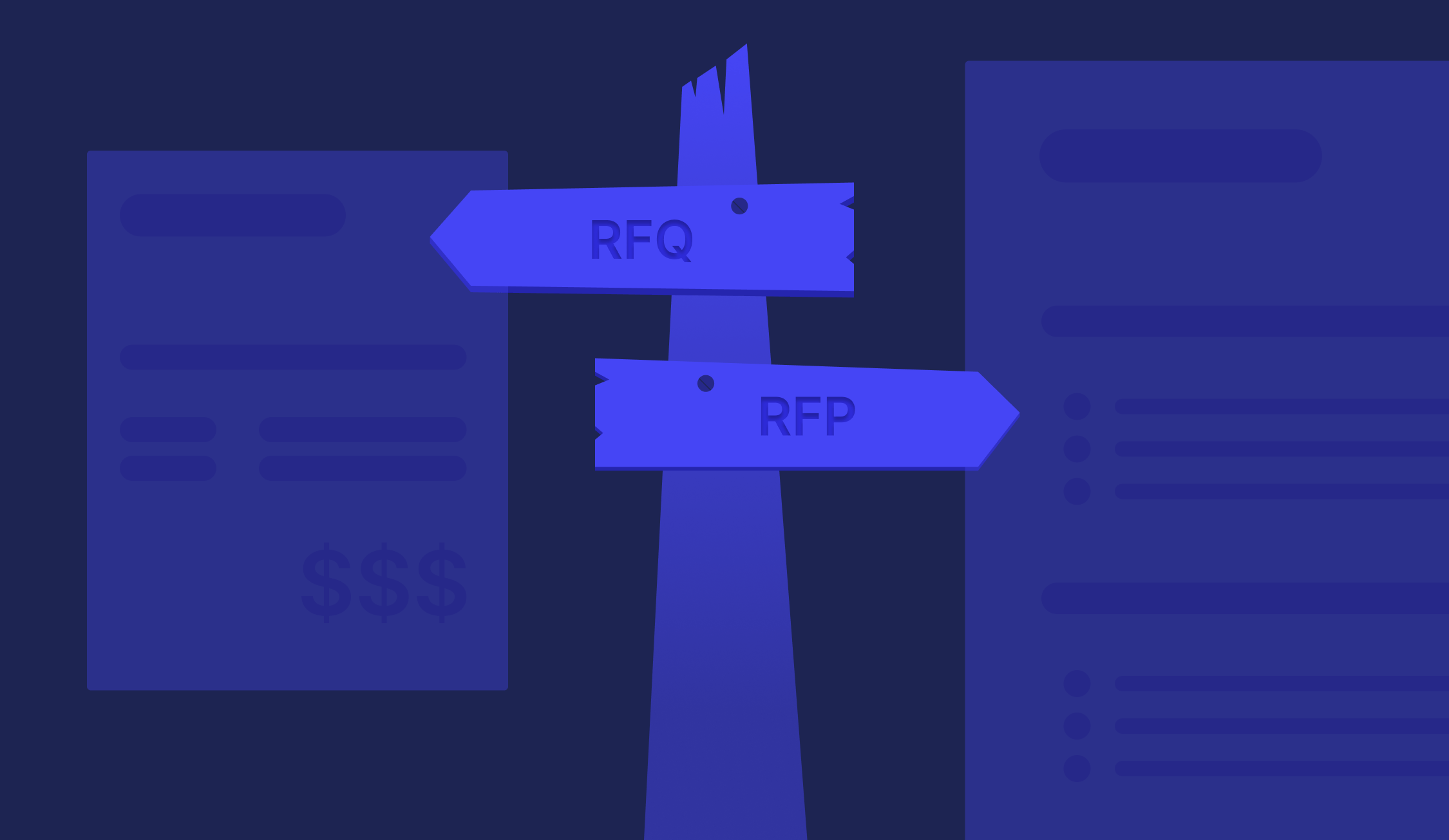
Considering the characteristics of requests for quotations, these documents are best suited for the following scenarios:
- You need standardized or off-the-shelf products and services where specifications are clear.
- You already know exactly what service or product you want, including exact quantities and requirements.
- You understand marketplace conditions and offerings related to the product or service in question.
- The primary evaluation factor is price, and vendors offering the lowest cost typically have an advantage.
For example, a tech company needs to purchase laptops for its employees. They know the exact model, specifications, and quantity required. Thus, they opt for an RFQ to efficiently compare options and choose the most cost-effective one.
On the other hand, requests for proposals are issued when:
- You are dealing with a large and complex project where overall objectives are known, but specific details are yet to be defined.
- You set specific parameters for the services and products and need vendors to present their creative solutions and unique action plans to fulfill project goals.
- The primary emphasis is on selecting a vendor based on their capabilities and proposed solutions rather than price.
For instance, say a manufacturing company intends to launch a line of eco-friendly packaging for its products. The company has a clear goal of enhancing sustainability but hasn’t defined specific details, such as the choice of materials, design concepts, and production processes. In this scenario, the manufacturing company would issue RFPs, inviting packaging design and production firms to propose creative and environmentally conscious solutions.
Best practices in managing RFQs and RFPs
Efficiently managing requests for quotations and requests for proposals is vital for optimizing sourcing, preventing inventory shortages, and ensuring effective vendor management. In light of this, we’ve prepared some tips to simplify the RFQ and RFP processes.
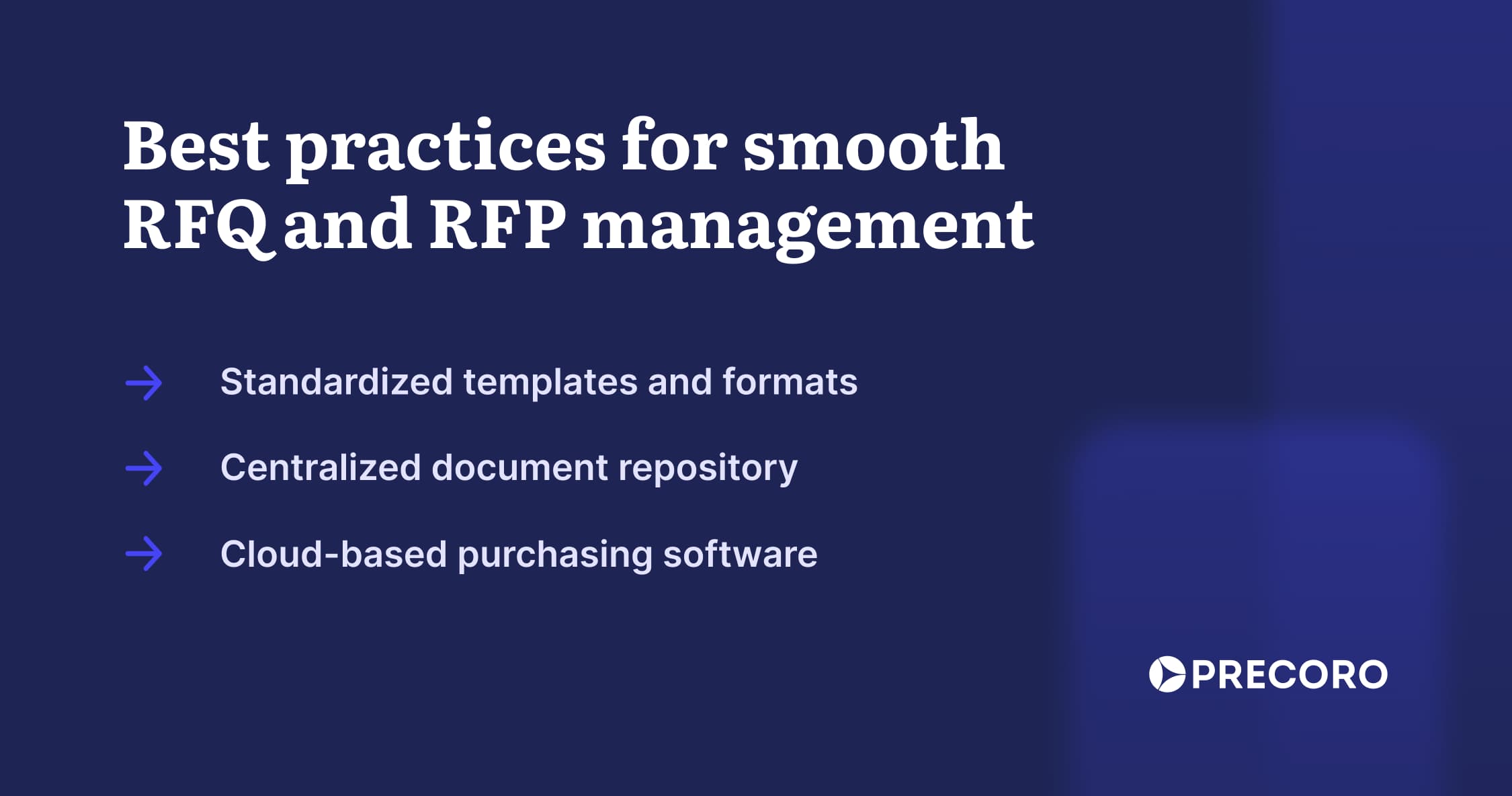
Standardized templates and formats
It’s a smart move for companies to adopt unified RFQ and RFP templates that will let them save time and not reinvent the wheel in each new sourcing process. In addition to saving time, a predefined structure helps procurement managers ensure that no critical data or question is overlooked in the document.
Moreover, it’s also important to explicitly outline expectations for vendors, including the required information, submission deadlines, and any specific response format. Interestingly, according to the RFP research conducted by the Art of Procurement and RFP360, the inability to ask clarifying questions or receive a post-RFP debrief is a common frustration reported by vendors. By providing a clear RFP document, companies can save potential suppliers from this hurdle.
Clarity in requirements, expectations, and response format contributes to comprehensive quotations and proposals from vendors and, as a result, saves the purchaser time on organizing data and chasing down missing or incomplete information. Thus, the company can enhance comparability among vendor responses and streamline the evaluation process.
Centralized document repository
To ensure document security and integrity, store all RFQs and RFPs in one place. Utilizing a shared space for document access simplifies team collaboration through comments and notes to discuss contents of the requests. Moreover, a specialized repository establishes an audit trail for both RFQs and RFPs.
The centralized document repository simplifies the retrieval and review of documents and improves procurement visibility across the company. It helps avoid duplication, which occurs when multiple departments request information from the same vendor or when the vendor is considered at different times.
Cloud-based purchasing software
Consider implementing a purchasing software solution to seamlessly integrate RFQs and RFPs into your overall procurement process. According to the Global Request for Proposal (RFP) Software Market Synopsis, there’s a growing demand for automating RFPs as cloud-based solutions provide more flexibility, scalability, and cost savings. Additionally, their accessibility from anywhere and anytime makes them more convenient for organizations.
Since purchasing software is a comprehensive solution for managing the whole procurement process, it efficiently connects RFQs and RFPs with relevant documents. For example, in the cloud-based purchasing software Precoro, users can create a request for proposal not only from scratch but also from purchase requisitions. Furthermore, users can manage other procurement documents in the system, like warehouse requests, purchase orders, invoices, and receipts.
Additionally, the company can send requests through the vendor management system, and once vendors respond, the platform stores their answers in the RFP file, and users can quickly review them later. Moreover, our supplier management software automatically assigns statuses to documents and propositions, indicating whether they have been sent, confirmed, rejected, completed, or otherwise updated.
Precoro provides an easy-to-use template that can be used to provide key data and request pricing information from prospective vendors, acting as an RFQ. Interestingly, it can also be used to create an RFP with additional project details and comprehensive questions through attachments and notes.
Frequently Asked Questions
The main difference between the documents is that an RFQ is used to seek detailed information on pricing. In contrast, an RFP document invites a detailed proposal, which includes the expertise of the responding vendors, their creative solution, and action plans for project fulfillment.
Organizations that need to make a purchase send RFPs and RFQs to potential vendors or suppliers. Usually, procurement managers within the company oversee these documents and vendor responses.
Making sense of RFQs and RFPs
According to the project, companies can choose to use RFQs or RFPs to initiate the formal process of vendor selection and identify the perfect vendor. These documents focus on different aspects. A request for quotation is used when companies know what they need to buy, including quantity and quality. Typically used for generic products and on-demand purchases, RFQs foster competition among vendors based on pricing and time to completion.
On the other hand, a request for proposal is utilized when organizations have defined project objectives but lack a clear roadmap. They call on vendors to outline their strategies and methodologies and showcase qualifications. Suited for large-scope and often long-term projects, RFPs encourage competition among vendors based on the overall value of their solutions.
Consistency and a comprehensive approach to every sourcing are best achieved by adopting predefined templates for RFQs and RFPs. Moreover, the selection process is more straightforward when vendor responses are also similar in structure, so it’s important to clearly outline the required information and any specific formats or templates for responses in the request. It’s also useful to establish a centralized document repository to have easy and reliable access to all RFQs and RFPs.
Nevertheless, implementing purchasing software is the most helpful tip for efficient RFQ and RFP management. Such a system not only addresses the need for standardized templates and secure document storage but also delivers additional value:
- It automatically assigns each document a status so that users can determine its current stage at a glance.
- The system allows a comprehensive review of vendor responses within each RFQ and RFP.
- Users can also create, approve, and manage other procurement documents like warehouse requests, purchase requisitions, purchase orders, invoices, receipts, and expense reimbursements.
- Included reporting features help purchasing managers analyze the stored data across various time frames.


